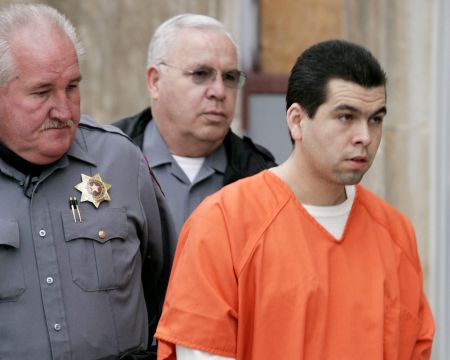A 44-year-old prisoner has been executed for the 1996 killing of a University of Oklahoma (OU) dance student.
Anthony Sanchez was pronounced dead at 10.19am local time following a three-drug injection at the Oklahoma State Penitentiary in McAlester.
Even though he maintained that he had nothing to do with the killing of 21-year-old Juli Busken, he took the unusual step of opting not to present a clemency application to the state’s Pardon and Parole Board, which many viewed as the last chance to save his life.
Shortly before he was put to death, the US Supreme Court rejected a request for a stay of execution submitted by his new lawyer, Eric Allen, of Columbus, Ohio. Mr Allen had said he needed more time to go through the case evidence.
Sanchez was convicted of raping and murdering 21-year-old Juli Busken, from Benton, Arkansas, who had just completed her last semester at the university when she was abducted on December 20 1996, from the car park of her Norman apartment complex.
Her body was found that evening near Lake Stanley Draper in far south-eastern Oklahoma City. She had been bound, raped and shot in the head.
Ms Busken had performed as a ballerina in several dance performances during her tenure at OU and was memorialised at the campus with a dance scholarship in her name at the College of Fine Arts.
Years later, Sanchez was serving time for a burglary conviction when DNA on Ms Busken’s clothing at the crime scene was matched to him. He was convicted and sentenced to die in 2006.
Sanchez has long maintained his innocence and did so again in a phone call to The Associated Press earlier this year from death row.
“That is fabricated DNA,” Sanchez said. “That is false DNA. That is not my DNA. I’ve been saying that since day one.”
He told the AP that he declined to ask for clemency because even when the five-member Pardon and Parole Board takes the rare step of recommending it, Governor Kevin Stitt has been unlikely to grant it.
“I’ve sat in my cell and I’ve watched inmate after inmate after inmate get clemency and get denied clemency,” Sanchez said. “Either way, it doesn’t go well for the inmates.”
Oklahoma attorney general Gentner Drummond maintained that the DNA evidence unequivocally linked Sanchez to Ms Busken’s killing.
“There is no conceivable doubt that Anthony Sanchez is a brutal rapist and murderer who is deserving of the state’s harshest punishment,” Mr Drummond said in a recent statement.
A private investigator hired by an anti-death penalty group contended that the DNA evidence may have been contaminated and that an inexperienced lab technician miscommunicated the strength of the evidence to a jury.
Former Cleveland County district attorney Tim Kuykendall, who was the county’s top prosecutor when Sanchez was tried, has said that while the DNA evidence was the most compelling at trial, there was other evidence linking Sanchez to the killing, including ballistic evidence and a shoe print found at the crime scene.
“I know from spending a lot of time on that case, there is not one piece of evidence that pointed to anyone other than Anthony Sanchez,” Mr Kuykendall said recently. “I don’t care if a hundred people or a thousand people confess to killing Juli Busken.”
Oklahoma resumed carrying out the death penalty in 2021, ending a six-year moratorium brought on by concerns about its execution methods.







